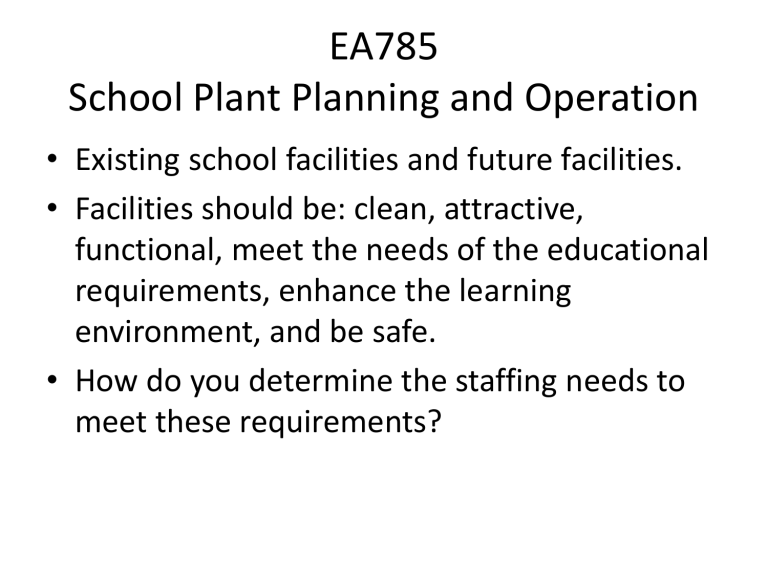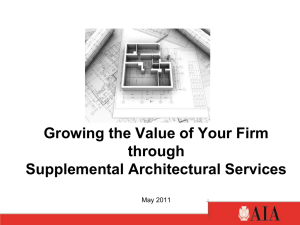EA785 School Plant Planning and Operation

EA785
School Plant Planning and Operation
• Existing school facilities and future facilities.
• Facilities should be: clean, attractive, functional, meet the needs of the educational requirements, enhance the learning environment, and be safe.
• How do you determine the staffing needs to meet these requirements?
Custodial/Maintenance Services
• Levels of perception of cleanliness: The level of cleanliness maintained in a school influences maintenance and operation (M&O).
• The underlying philosophy for M&O should be that “the school can never be too clean, safe, healthy, or secure.”
• Districts should have a well defined “chain of command” for the house-keeping and maintenance program.
Custodial/Maintenance Services Cont.
• Each district should have well defined job descriptions for all staff members, including those working in house-keeping and maintenance.
• High quality custodial services require planning and scheduling workloads and an adequate budget.
• There are a variety of variables that determine how many staff are required to clean/service a facility.
Custodial/Maintenance Cont.
• Factors include: Level of cleanliness desired, type of facility (labs, shops, classrooms, restrooms, locker rooms, etc.), types of surfaces to be cleaned (carpet, tile, etc.), age of facility, equipment available to staff, number of students occupying the building, location of cleaning items, etc.
• Baker and Peters (1957, pp. 77-78) outlined a six step formula for developing a custodial workload.
Six Step Cont.
• Step 4: Given one custodian for every 15,000 square feet of usable area of building, find the square footage factor (SF): Total Square
Footage/15,000=square footage factor (SF)
• Step 5: Given one custodian for each 2 acres of ground that is maintained, find the grounds factor (GF): Acres maintained/2= grounds factor (G
Six Steps Cont.
• Step 6: Sum the five factors and divide by 5, and add the CK factor to find the number of cleaning custodians needed. Frohreich (1987) suggested the CK factor for cafeteria (0.1) and kitchen (0.2).
Custodial/Maintenance Cont.
• While this formula may not work for all districts, it is a good guide.
• It is important to schedule custodial activities in such a manner that they do not interfere with the educational program. Major cleaning should take place in the evening or at night.
• Keep in mind “outdoor” maintenance may also be a distraction, such as mowing grass.
Maintenance Schedule
• It is extremely important to keep facilities and equipment in good working order and well maintained. This includes, playground equipment, shop equipment, lab equipment, and athletic equipment maintained.
• Develop a maintenance schedule checklist for all facilities and equipment.
• Keep in mind that properly maintained equipment is more efficient, and provides a safe environment.
Facility Safety
• In addition to providing a clean environment, it is important to provide a safe environment.
• You need to conduct routine visual inspections of all facilities to ensure there are no safety issues.
• DESE web site provides many safety check list.
• In addition to preventing injuries, this will also prevent litigation.
Crowding and School Capacity
• Crowding and density are factors in safety and security.
• The crowding of too many students into spaces designed for learning increases the chances of structural abuse, furniture abuse, mechanical overloads, increased behavior problems, and lower achievement.
• Sufficiency of space is judged by many variables, including curriculum functions.
Facility Construction
• When it is determined that additional space is needed or when current facilities are deemed unsafe, or outdated, most districts will develop plans for new facilities.
• There are a variety of ways to fund new facilities, however, bond issues or lease purchase agreements are the most common.
Facility Construction Cont.
• There are many steps in the planning process.
• Planning for new school buildings or major renovations to existing facilities requires considerable effort on the part of many highly skilled professional and technical personnel both inside and outside of the school system.
• Earthman (2000) identified eleven steps in the planning of new school facilities.
Facility Construction Cont.
• Those steps include: Organize the staff,
Determine the size of the student population,
Select and acquire a site, Select an architect,
Develop a funding plan, Develop a set of educational specifications, Monitor the design, Advertise/bid the project, Monitor construction, Orient the staff to the building, and Evaluate the building and planning process.
Facility Planning Process
• Planning, designing, and building schools is an awesome responsibility, and should be a shared responsibility.
• The first action is to assemble a school planning team which may consist of representatives of the administration, board of education, teachers, non-professional personnel, and out-side consultants.
Facility Planning Cont.
• This group should develop a short range and a long range plan of action for facilities.
• Once this plan is developed, progress should be reviewed on an annual basis.
• The plan should list a timeline, estimated cost, and should be prioritized.
• A long range plan can be for a minimum of three years to as many as ten or twelve years.
Facility Planning Cont.
• Once the plan has been developed, it will be time to implement facility improvements, and/or construct additions or new facilities.
• When it is time to begin implementing the facility plan, it will be time to involve an architect.
The Architect and Services Provided
• The primary role of the architect is to translate, from the educational specifications, the needs and wants of the school district into a set of working documents from which the contractor can construct the desired facility.
• The selection of an architect is the most important part of any building project.
Selection of an Architect
• The district should invite proposals from architects. A pre-qualification questionnaire should be developed by the school asking the architect questions that are of interest to the district and valuable in the selection process.
Selection of Architect Cont.
• The district questionnaire should include:
1.
Where is the firm located?
2.
How many years has the firm been in business?
3.
What experience does the firm have in school design?
4.
How many staff members are in the firm?
5.
Does your firm provide consultants?
6.
Will you provide and energy cost analysis?
7.
What is your fee?
8.
What is timeline from preliminary drawings to final drawing specifications?
9.
What services are provided for the fee?
10. How often will you visit the job site?
11. Has a school district ever brought legal action against your firm?
12. Have you ever brought legal action against a school?
13. How do you handle change orders?
14. What are your current projects?
Architect Cont.
• After the board has selected an architect, the one major thing left is to develop a contract with the architect.
• The standard AIA Contract is a good document to begin with. Make sure all items are addressed in detail in the agreement, especially fees and supervision of the project.
• Districts should use adequate legal advise when preparing the contract.
Architect Cont.
• A check list of features that should be covered in contracting are as follows:
1. The length of contract.
2. The method of terminating contract.
3. Payment, fees, and/or services.
4. Payments to architect-schedule.
5. Supervision
6. Ownership of blueprints, documents
7. Board approval of plans required prior to advertising for bids
8. Payments for major plan changes
Architect Cont.
• The district should always have a written document agreement with the architect that fully describes the project, the services to be performed by the architect, the compensation to be paid, and the owner’s obligation to the architect. If a project is abandoned, or if for other reasons the architects normal services are not completed, the architect is normally paid that portion of the normal fee calculated on a percentage basis.
Architect Cont.
• Typically, the architect works closely with the administration, school board, and others chosen to be involved, to learn all they can about the project, such as; Intended use, anticipated educational programs, past and estimated pupil population, teaching methods to be used, needs and wants, type and quality of construction, and budget.
Architectural Services
• Programming
• Preliminary design
• Design development
• Working drawings
Programming
• With this information the architect can determine:
1. The necessary number of spaces
2. Proper size of spaces
3. Location and spatial relationships of rooms
4. Estimate of construction
This process is called “programming”.
Programming Cont.
• Programming is necessary prior to design to assure that the project will fit the needs of the district. It also provides the Board and
Administration, very early in the project, with the best assurance that all necessary spaces have been included, and to make sure the project will be within the budget before beginning a design.
Preliminary Design
• Translates educational specifications into building spaces
• Cost analysis is performed
• Unit costs are calculated
• Decisions are made by the board as to what needs to be deleted or added depending on cost projections.
Design Development
• Drawings are made that reflect the size and character of the project.
• Structural, mechanical, and electrical systems are set forth.
• Building materials are selected.
• Presented to the Board for approval.
Working Drawings
• Provide contractor with construction information about the project pertaining to:
1. Quality
2. Dimensions
3. Configurations
4. Locations
5. Relationships of proposed structure to existing structures
Architectural Specifications
• Used to establish bidding and construction information for competing contractors
• Establish expected quality of construction
• Outline types of fixtures, material, and finishes to be used.
• Delineate codes and standards that must be followed in construction.
Final Cost Estimates
• Based upon complete, detailed working drawings.
• Related directly to architectural specifications agreed upon by the board.
• Include cost estimates for all components of the project.
Architect’s Bidding Assistance
• Assist owner in advertising for bids. All school districts should have district policy which outlines bidding requirements.
• Assists owner in issuing construction documents to bidders
• Assists in setting date for bid award
• Presides at bid opening
• Advises the board on legality of all bids
• Advises board on competence of the bidders and their ability to perform.
Architect
• Critical to the success of any project
• The person who can assure the correct completion of work.
• Must be competent, talented, trustworthy, reputable, and detail oriented.
• Bonded
Facility Site Location
• The farsighted school board and administration will project their school site needs well into the future and acquire adequate sites while land is still available and relatively economical.
• In selecting a school site, the following basic criteria should be considered:
Facility Site Cont.
1. Economic, social, and housing makeup of the community.
2. Integration with community planning and zoning.
3. Site location and usability of site for building, recreation, as it pertains to water table, flood plain, subsoil conditions.
4. Relationship of schools to other buildings in the district.
5. Utility services as related to availability and cost.
6. Size of site.
Size of School Site
• The size of a school site should be determined largely by the nature and scope of the contemplated educational program.
Numerous state authorities have developed recommendations for site size.
Size of School Site
• Recommendation of school sites are as follows:
• Elementary Schools-Suggested size is 10 Acres plus one additional acre for each 100 students.
An elementary of 500 students should have 15 acres.
• Middle School-Suggested size is 20 acres plus one addition acre for each 100 students.
• High School-Suggested size is 30 acres plus one additional acre for each 100 students.
Recommend Instructional Space Size
• The Department of Elementary and Secondary
Education has recommended square footage for all instructional areas in the school.
• The web address to access this information is: http://dese.mo.gov/divadm/govern/safety.ht
ml
Bond Issues
• The most common source of funding for school buildings projects is the bond issue.
• Missouri Statute Section 164.121 identifies the purposes for bond issues as follows:
1. Purchasing schoolhouse sites and other land for school purposes.
2. Erecting schoolhouses or library buildings.
3. Furnishing schoolhouses or library buildings
Bonds Cont.
4. Building additions to or repairing old buildings.
5. Purchasing school buses and other transportation equipment.
6. Paying off and discharging assessments made by political subdivisions or public corporations of the state against the district in connection with construction. (ie sidewalks, sewers, etc.)
Bond Issue Procedures
• Determination of building needs using an architect.
• Determination of bonding capacity (15% of assessed valuation).
• Selection of bond council
• Election campaign, ballot language, election date.
Bond Procedure Cont.
• Preparation of bond maturity schedule
• Selection of paying agent.
• Preparation for bond sale.
• Bond ratings
• Publication of the sale
• Sale of bonds
Selection of Financial Consultant
• This is a very important decision as this individual/firm will oversee most of the details of the bond issue requirements from sample ballot language through the sale of the bonds and the development of the payment schedule.
• The firm usually charges a percent fee for services.
Sale of Bonds
• Negotiated sale requires no competition for the sale of bonds. Generally the consultant you employ will conduct the sale.
• Public sale is competitive bidding with an advertised date and a specified time, place, and date when the bidding will take place.
Rated vs. Non-Rated
• Rated by Moody’s of Standard and Poors
• Rating levels such as AAA, AA, A, BBB, BB, etc.
• The highest rated bonds are considered the most safe investment and bring lower interest rates.
Bond Elections
• In Missouri bond issues are approved with a
4/7 majority when the following elections are held: municipal elections, primary elections, general elections.
• Any other time, bond election is held requires a 2/3 majority to pass.
Passing a Bond Issue
• Each district is unique and has a unique set of challenges when it comes to passing bond issues.
• There are several steps that should be taken when promoting a bond issue.
• Organize a task force or committee to assist with the promotion of the issue.
Passing a Bond Issue Cont.
• Develop small committees with committee leaders to work on different areas of promotion such as; phone campaign, door to door literature campaign, media campaign, club and organization speaker, etc.
• Raise funds for advertising. Remember, school funds CANNOT be used to promote the bond issue.
Passing a Bond Issue
• Identify number of voters that voted in last election.
• Identify school employees that live in the district and voted in the last election and that are registered voters.
• Concentrate on Yes votes.
• Once you have passed the issue, celebrate the victory and remember to thank the patrons of the district.
After the Bond Issue Passes
• The construction contract should; specify the expected completion date, provide for penalty clauses and liquidated damages if not completed on time, insure builder has liability and builder’s risk insurance.
Bidding Procedures
• Advertise for bids
• Furnish plans and specifications to bidders
• Provide adequate time to submit bids, usually
4 weeks.
• Public opening of bids on specified time and date. Late bids will not be opened.
• Award contract.
Completion of Building Project
• Once bids have been “let”, the district and the architect and or construction manager should closely monitor progress.
• Generally, there will be weekly meetings between the architect, contractor, and district officials to review progress and note any issues.
• Once the facility is complete, the architect along with the district should complete a “punch list” prior to accepting the building.
Punch List
• A punch list is a listing of all items that do not meet with the satisfaction of the owner. These can be minor issues such as replacing a few tiles, paint touch-up, etc. When the issues are minor it is common to accept the building and withhold a small amount of the final payment until all issues are addressed.
Open House
• Once the building is complete it is important to have an open house for the public and thank them for the new facility.
• After the building is occupied, it is time to begin to put together a maintenance schedule to make sure the facility functions efficiently and is attractive for years to come.
• Now it is time to begin the planning process all over.








